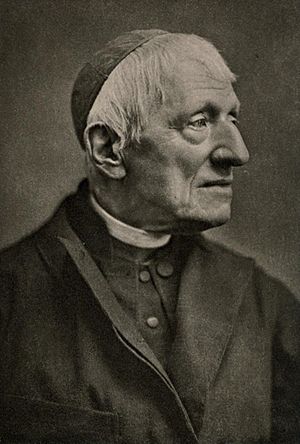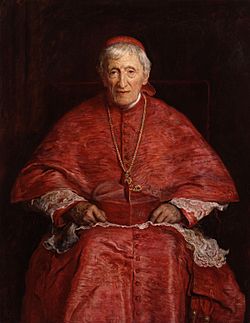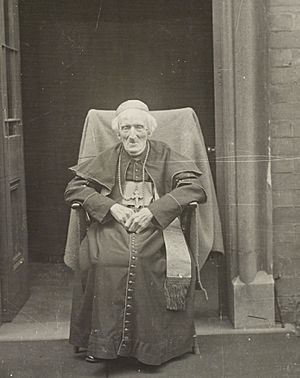John Henry Newman facts for kids
Quick facts for kids Saint John Henry Newman CO |
|
|---|---|
| Cardinal Deacon of San Giorgio in Velabro | |

Photograph by Herbert Rose Barraud, c. 1885
|
|
| Church | Catholic Church |
| Appointed | 15 May 1879 |
| Reign ended | 11 August 1890 |
| Predecessor | Tommaso Martinelli |
| Successor | Francis Aidan Gasquet |
| Other posts |
|
| Orders | |
| Ordination |
|
| Created Cardinal | 12 May 1879 |
| Rank | Cardinal deacon |
| Personal details | |
| Birth name | John Henry Newman |
| Born | 21 February 1801 London, England |
| Died | 11 August 1890 (aged 89) Edgbaston, Birmingham, England |
| Buried | Oratory Retreat Cemetery Rednal, Metropolitan Borough of Birmingham, West Midlands, England |
| Nationality | British |
| Denomination |
|
| Parents |
|
| Alma mater | Trinity College, Oxford |
| Motto | Cor ad cor loquitur ('Heart speaks unto heart') |
| Signature | |
| Coat of arms |  |
| Sainthood | |
| Feast day |
|
| Venerated in | |
| Beatified | 19 September 2010 Cofton Park, Birmingham, England by Pope Benedict XVI |
| Canonized | 13 October 2019 Saint Peter's Square, Vatican City by Pope Francis |
| Attributes | Cardinal's attire, Oratorian habit |
| Patronage | Personal Ordinariate of Our Lady of Walsingham; poets |
| Shrines | Birmingham Oratory |
John Henry Newman (born 21 February 1801 – died 11 August 1890) was an important religious leader in England during the 1800s. He was a poet and a deep thinker about religion. First, he was a priest in the Church of England. Later, he became a Catholic priest and a cardinal. He was well-known across England by the mid-1830s.
Contents
Early Life and Education
John Henry Newman was born in London on 21 February 1801. He was the oldest of six children. His father, John Newman, worked as a banker. His mother, Jemima, came from a family of Huguenot refugees. His younger brother was Francis William Newman. His sister, Harriet Elizabeth, married Thomas Mozley, who was also important in the Oxford Movement.
When he was seven, Newman went to Great Ealing School. He loved reading novels by Walter Scott and Robert Southey. By age 14, he was reading books by thinkers like Thomas Paine and David Hume.
Newman later went to Trinity College at Oxford University. He studied many subjects. He wanted to do well in his final exams but became too worried. He didn't get the highest grades.
Still, Newman wanted to stay at Oxford. He taught students privately and studied for a special position called a "fellowship" at Oriel College, Oxford. Oriel College was a very important place for thinkers at Oxford. He became a fellow there on 12 April 1822.
Newman's Religious Journey and Career
On 13 June 1824, Newman became an Anglican deacon. A deacon is a church leader who helps the priest. He preached his first sermon ten days later. On 29 May 1825, he became an Anglican priest. For two years, he worked at St Clement's Church, Oxford. He also wrote articles for an encyclopedia.
Newman started as an evangelical scholar and priest. But he became interested in the "high-church" side of Anglicanism. This group wanted to bring back some Catholic traditions to the Church of England. Newman became a leader of the Oxford Movement. This group was very influential and sometimes caused arguments.
In 1841, Newman wrote a controversial paper called Tract 90. After this, he felt he could no longer be part of the Anglican Church. In 1845, he left the Church of England and became a Catholic. Many of his followers joined him. He quickly became a Catholic priest. He continued to be an important religious leader in Birmingham.
In 1854, Catholic bishops in Ireland asked Newman to lead a new university. He became the first leader of the Catholic University of Ireland in Dublin. Today, this is University College Dublin. He wrote a book called The Idea of a University. This book shared his ideas about education.
Newman was also a talented writer. His famous works include his life story, Apologia Pro Vita Sua, and a book about faith called Grammar of Assent. He also wrote a long poem, The Dream of Gerontius. This poem was later turned into music by Edward Elgar. He also wrote popular hymns like "Lead, Kindly Light".
Later Years and Becoming a Saint
In 1878, Newman's old college at Oxford made him an honorary fellow. He visited Oxford again after 32 years. In 1879, Pope Leo XIII made him a cardinal. This was to honor his work for the Catholic Church in England.
After becoming a cardinal, Newman returned to England. He lived at the Birmingham Oratory until he died. He still visited London and his old friend, Richard William Church. He wrote a few more articles.
Newman's health began to get worse in 1886. He died on 11 August 1890 from pneumonia at the Birmingham Oratory. He was buried next to his close friend, Ambrose St. John. The cloth over his coffin had his cardinal's motto: Cor ad cor loquitur. This means "Heart speaks unto heart." Their shared gravestone has another motto Newman chose: Ex umbris et imaginibus in veritatem. This means "Out of shadows and phantasms into the truth."
Becoming a Saint: Canonisation
In 1991, Pope John Paul II declared Newman "venerable." This means his life and work were studied and found to be very holy.
In 2001, an American deacon named Jack Sullivan said he was healed from a serious spinal problem. He believed this healing happened because he prayed to Newman. The Catholic Church accepted this as a miracle. This led to Newman's beatification. Pope Benedict XVI announced this on 19 September 2010 during his visit to the United Kingdom.
Another miracle was approved in 2018. This was the healing of a pregnant woman from a serious illness. This second miracle meant Newman could become a saint.
On 13 October 2019, Pope Francis officially declared John Henry Newman a saint. This happened in Saint Peter's Square in Vatican City. Charles III, who was then the Prince of Wales, attended the ceremony.
When is Saint Newman's Feast Day?
| Saint John Henry Newman C.O. |
|
|---|---|

Portrait of Cardinal Newman in choir dress
by John Everett Millais, 1881 |
|
| Priest and Confessor | |
| Born | 21 February 1801 |
| Died | 11 August 1890 (aged 89) |
| Venerated in | Catholic Church |
| Beatified | 19 September 2010 by Pope Benedict XVI |
| Canonized | 13 October 2019 by Pope Francis |
| Major shrine | Birmingham Oratory |
| Feast | 9 October |
| Attributes | Cardinal's attire, Oratorian Habit |
| Patronage | Personal Ordinariate of Our Lady of Walsingham |
In the Catholic Church, saints are usually celebrated on the day they died. This is seen as their "birth into heaven." However, Newman died on 11 August. This is the same day as a very important saint, Saint Clare of Assisi.
So, Newman's feast day is celebrated on 9 October. This is the day he became a Catholic. This date was also chosen because it is at the start of the university year. Newman cared a lot about education.
John Henry Newman is also remembered in the Church of England on 11 August. The Episcopal Church remembers him on 21 February.
Newman's Impact on Education
Newman started the Catholic University School for boys in Dublin. He also founded the Catholic University of Ireland. This university later became University College Dublin. It has greatly helped Ireland's education and society.
Many groups and colleges around the world are named after Newman. These include "Newman Societies" or "Newman Centers." They help Catholic students at universities that are not Catholic. Colleges named after him can be found in Birmingham, Melbourne, Edmonton, Thodupuzha, and Wichita.
Newman's ideas about education are still important today. His lectures, The Idea of a University, suggest that education should create well-rounded people. He believed that subjects like arts and pure science train the mind in ways that help with many different jobs.
Works by John Henry Newman
Here are some of the books and writings by John Henry Newman:
From His Anglican Period
- The Arians of the Fourth Century (1833)
- Tracts for the Times (1833–1841)
- British Critic (1836–1842)
- Lyra Apostolica (poems, 1836)
- On the Prophetical Office of the Church (1837)
- Lectures on Justification (1838)
- Parochial and Plain Sermons (1834–1843)
- Select Treatises of St. Athanasius (1842, 1844)
- Lives of the English Saints (1843–44)
- Essays on Miracles (1826, 1843)
- Oxford University Sermons (1843)
- Sermons on Subjects of the Day (1843)
From His Catholic Period
- Essay on the Development of Christian Doctrine (1845)
- Retractation of Anti-Catholic Statements (1845)
- Loss and Gain (novel – 1848)
- Faith and Prejudice and Other Unpublished Sermons (1848–1873; collected 1956)
- Discourses to Mixed Congregations (1849)
- Difficulties of Anglicans (1850)
- The Present Position of Catholics in England (1851)
- The Idea of a University (1852 and 1858)
- Cathedra Sempiterna (1852)
- Callista (novel – 1855)
- On Consulting the Faithful in Matters of Christian Doctrine (1859)
- The Rambler (editor) (1859–1860)
- Apologia Pro Vita Sua (religious autobiography – 1864; revised edition, 1865)
- Letter to Dr. Pusey (1865)
- The Dream of Gerontius (1865)
- An Essay in Aid of a Grammar of Assent (1870)
- Sermons Preached on Various Occasions (various/1874)
- Letter to the Duke of Norfolk (1875)
- Five Letters (1875)
- Sermon Notes (1849–1878)
- Select Treatises of St. Athanasius (1881)
- On the Inspiration of Scripture (1884)
- Development of Religious Error (1885)
Other Writings
- Historical Tracts of St. Athanasius (1843)
- Essays Critical and Historical (various/1871)
- Tracts Theological and Ecclesiastical (various/1871)
- Discussions and Arguments (various/1872)
- Historical Sketches (various/1872)
- Addresses to Cardinal Newman and His Replies, with Biglietto Speech (1879)
Selections of His Works
- Realizations: Newman's Own Selection of His Sermons (edited by Vincent Ferrer Blehl, S.J., 1964). Liturgical Press, 2009. ISBN: 978-0-8146-3290-1
- Mary the Second Eve (compiled by Sister Eileen Breen, F.M.A., 1969). TAN Books, 2009. ISBN: 978-0-89555-181-8
Images for kids
-
Statue outside the Church of the Immaculate Heart of Mary, also known as Brompton Oratory, in London
-
Newman's desk in the Birmingham Oratory
-
Newman's room in the Birmingham Oratory
See also
 In Spanish: John Henry Newman para niños
In Spanish: John Henry Newman para niños












